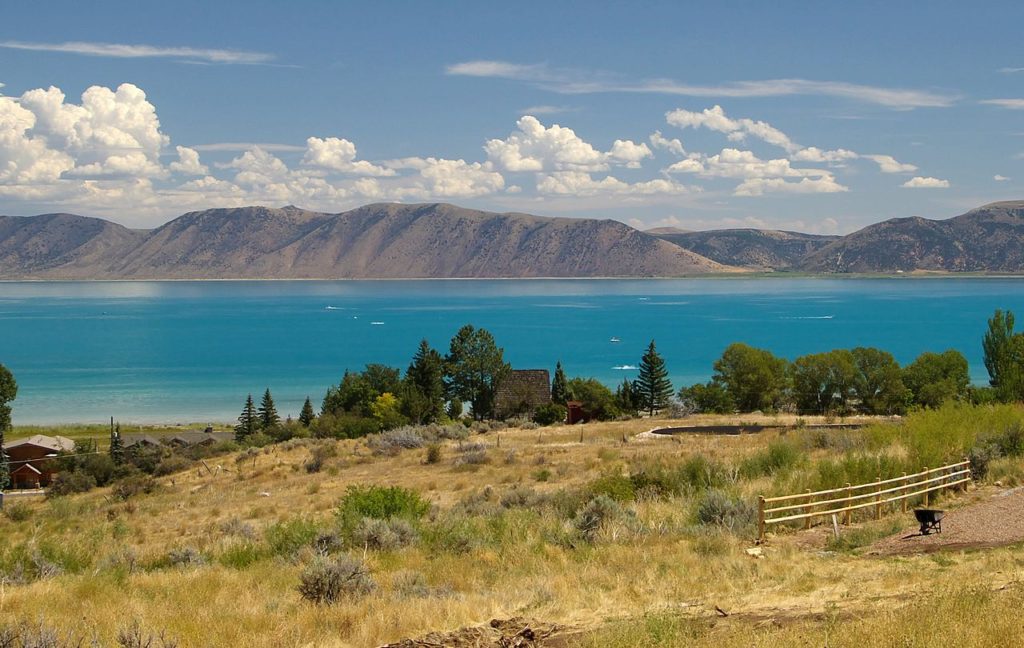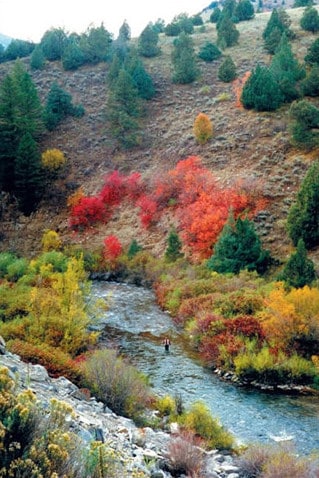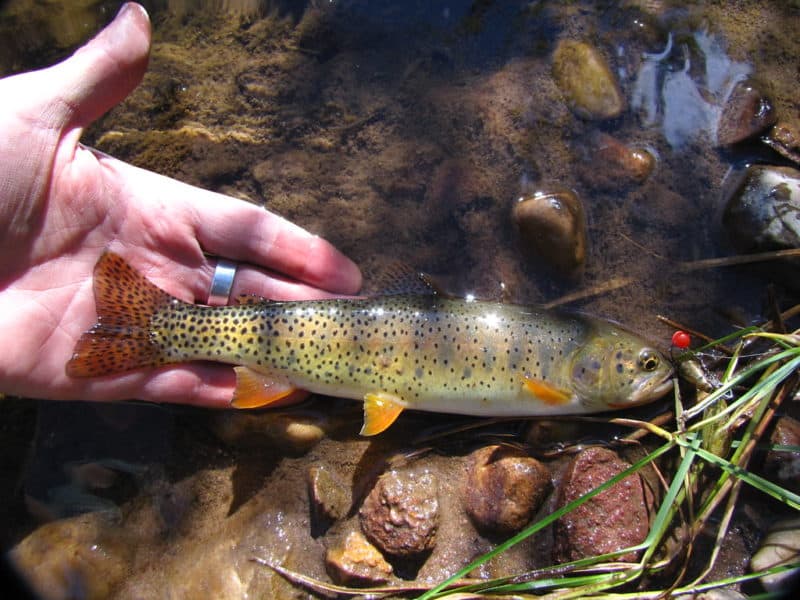The Bear River cutthroat is one of the big four in the Utah Cutthroat Slam. The following article will explain some of the differences and similarities between them and other Bonneville Cuts and also where you can find them around the State of Utah.
There is some dissension about whether Bear River Cutthroat Trout should be classified as a separate subspecies from Bonneville Cutthroat Trout. They Have been geographically isolated enough that they possess some phenotypical differences. According to Robert Behnke’s “Trout and Salmon of North America,” Bear River Cutthroat Trout has on average 15 more scales along their sides and 8 more pyloric ceca than do other Bonneville Cutthroat Trout populations. Cutthroat Trout from Bear lake also tends to live longer and grow larger than other Bonneville Cutthroat Trout populations.
The folks over the Utah Cutthroat Slam believe that these differences are sufficient to score an exclusive spot on their list of native Trout species.
Here is the official Utah Cutthroat Slam Policy quoted from their website regarding fish caught from the Weber and Ogden rivers. “While the Weber River (including the Ogden River) is not in the Bear River Drainage, the Bonneville cutthroat trout in these drainages historically mixed with Bear River cutthroat trout and cutthroat trout angled in these drainages can count toward either the Bear River or Bonneville cutthroat trout catch, BUT NOT BOTH. FOR EXAMPLE, IF YOU CLAIM A BONNEVILLE CUTTHROAT TROUT CATCH FROM THE WEBER RIVER, THEN YOU NEED TO CATCH A BEAR RIVER CUTTHROAT TROUT FROM A DIFFERENT DRAINAGE AND VICE VERSA”.
In the Wyoming Cut-Slam, their Bonneville Cutthroat Trout all actually reside in the Bear River drainage. It all becomes very confusing. See: Where are the Bonneville Cutthroat Trout in Wyoming?
Behnke calls the Bonneville Cutthroat trout a minor subspecies of the major subspecies, Yellowstone Cutthroat Trout. If that’s the case, maybe Bear River Cutthroat is a minor subspecies of a minor subspecies. Don’t take my word on that. It’s just an unqualified opinion.
According to Behnke, the first entry of Cutthroat Trout into the Bonneville Basin likely occurred through the Bear River around 30,000 years ago. Up until that time, the Bear River was a tributary of the Snake River. Lava flows blocked the Bear river’s northward course and sent it south into the Bonneville Basin.
The extra flow from the Bear River was sufficient to raise Lake Bonneville’s level to the point that it cut an outlet at Red Rock Pass, Idaho, sending an enormous amount of water back into the upper Snake River Basin. This event also dropped the level of Lake Bonneville by approximately 350 feet.
Over the next 7000 or so years, Lake Bonneville continued to recede, leaving its remnants in places like the Great Salt Lake and Utah Lake and leaving isolated populations of its apex predator, the Bonneville Cutthroat Trout.
In the Bear River Cutthroat Trout’s specific history, Bear lake was never submerged by Lake Bonneville. According to information on the Bear River Watershed information system website. However, an irrigation canal now connects the Bear River and Bear Lake; they’ve joined together naturally during wet periods many times over the last several hundred thousand years. This is why Bear River Cutthroats are native to the lake as well.
Places to catch Bear River Cutthroat Trout in Utah

Rich County Utah
1-Bear Lake
Bear Lake is a trophy fishery for both Bear River Cutthroat and Lake Trout. The Idaho state record Cutthroat Trout was caught in Bear Lake. It sits on the Utah, Idaho border and is split about evenly between the two states. Consequently, if you have either a Utah or an Idaho license, you can fish in both states. It comprises around 109 square miles of surface area. On average, it’s 94 feet deep with a maximum depth of 208 feet. It’s around 41 miles to Bear Lake from Logan, Utah. Take Us 89 through Logan Canyon.
Successful fishing can be done from shore, but your best bet is trolling with a downrigger due to the Lake’s depth. Jigging from a boat is also popular, especially in the summer’s heat, fish hold close to the bottom. Fishing is open year-round at Bear Lake. The following quote is from the Bear Lake Fishing Report. “Remember, the trout limit is two fish. Cutthroat trout with a healed fin clip may be kept; cutthroat trout with all fins intact must be immediately released.”
Fin clipped fish have been stocked in the lake, while those with intact fins are wild-born trout. The following is from the Utah DWR Facebook page. “Each spring, we divert cutthroat trout to a fish trap on Swan Creek, a tributary to Bear Lake.
Once inside the facility, we net the fish and put them in a solution that relaxes them. Next, they’re measured, tagged, and weighed. Then, it’s time to extract their eggs and milt.
We take the mixture to our hatcheries. There, the eggs hatch, and tiny cutthroat trout grow to 7 inches before they’re stocked in Bear Lake the following spring.”
2-Woodruff Creek Reservoir
Woodruff Creek Reservoir is 32 miles from Evanston, Wyoming. Take Wy-89 northwest to the Utah Border for 11.6 miles. In Utah, continue on Ut-16 north for another 10.4 m
Woodruff Creek reservoir is 20 miles from Randolph, Utah. Take Ut-16 south for 10.1 miles. At this point, turn right onto Ut-39 and follow it 5.6 miles. Now turn left onto Woodruff Creek road and follow it a little less than a mile to the reservoir.
The boat ramp at Woodruff Creek Reservoir is not suitable for anything more than a small craft.
3- Big Creek
Big Creek crosses under UT-16 south of the city of Randolph. It has a population of Bear River Cutthroat Trout. It travels through a lot of private ground, though, so do your homework before embarking on a Big Creek fishing expedition.
Randolph Creek is Big Creek’s largest tributary. It also has Bear River Cutthroat Trout. Watch the video below for more on Randolph Creek.
4- Otter Creek
Otter Creek is ambiguous. The following quote is from the Utah Cutthroat Slam website. I haven’t been able to find any update beyond this.” Otter Creek (all three headwater forks). This stream is being chemically restored to native BRCT during 2015-2016. Please contact the Northern Region UDWR Office (801-476-2740) for BRCT fishing opportunities in this stream.”
Cache County Utah

1-Logan River
Logan River above 3rd dam is managed for Bear River Cutthroat Trout. In explanation, as you follow the Logan River up the Canyon from the city of Logan, it is backed up into several mini reservoirs, 1st dam, 2nd dam, and 3rd dam.
The Logan River is closed to fishing from January 1st to the second Saturday in July. Fishermen are limited to the use of artificial flies and lures. The take limit is two trout or whitefish. (a combined total)
2- The Blacksmith Fork River
The Blacksmith Fork River is just out of Hyrum, Utah. According to the Utah Cutthroat Trout Slam website, there are some Bear River Cutthroat Trout in the Blacksmith Fork of the Logan River. Still, there are stronger population densities in the Lefthand Fork, Rock Creek, and Curtis Creek. These are all tributaries of the Blacksmith Fork River.
You can access the Lefthand Fork of the Blacksmith Fork 7.1 miles out of Hyrum, Utah. Take Ut-101 7.1 miles up Blacksmith Fork Canyon to the Lefthand Fork trailhead.
Rock Creek and Curtis Creek come together around 11 miles from Hyrum, Utah, to form the Blacksmith Fork of the Logan River. Again, take Ut-101 from Hyrum around 11 miles up Blacksmith Fork Canyon to the Rock Creek and Curtis Creek forks of the Blacksmith Fork River.
Summit, Morgan, and Weber Counties in Utah
1-The Weber River and its headwaters
From the Utah Cutthroat Slam website, “The Weber River from the confluence with the Ogden River upstream to Echo Dam is managed by the UDWR for native cutthroat trout (Bear River/Bonneville cutthroat trout).”
- The Weber River and its tributaries from the town of Oakley, UT, upstream to the headwaters is managed by the UDWR for native cutthroat trout (Bear River/Bonneville cutthroat trout).
- Beaver Creek (upstream from Kamas) is managed by the UDWR for native cutthroat trout (Bear River/Bonneville cutthroat trout).
- South Fork of the Ogden River is managed by the UDWR for native cutthroat trout (Bear River/Bonneville cutthroat trout).
- Wheeler Creek Angling conditions can be tough as Wheeler Creek is a small, brushy stream and is managed by the UDWR for native cutthroat trout (Bear River/Bonneville cutthroat trout).
- Wolf Creek Angling conditions can be tough as Wolf Creek is a small, brushy stream and is managed by the UDWR for native cutthroat trout (Bear River/Bonneville cutthroat trout).”
I hope reading this article has been as informative for you as writing it has been for me.
The more I learn about our native Trout species, the more I appreciate them and realize their importance. I hope it’s the same for you.
Now get out there and pursue some Bear River Cutthroat Trout, hopefully in a place you’ve never been before, somewhere around the great state of Utah.
Recent Posts
The only venomous snakes in Washington State are Northern Pacific Rattlesnakes. The Northern Pacific Rattlesnake (Crotalus oreganus oreganus) is a sub-species of the Western Rattlesnake. Anyone...
Skunks are not classified as true hibernators. But they go into a state of torpor when the weather gets cold. Skunks are light sleep hibernators, along with opossums, bears, and raccoons. ...

